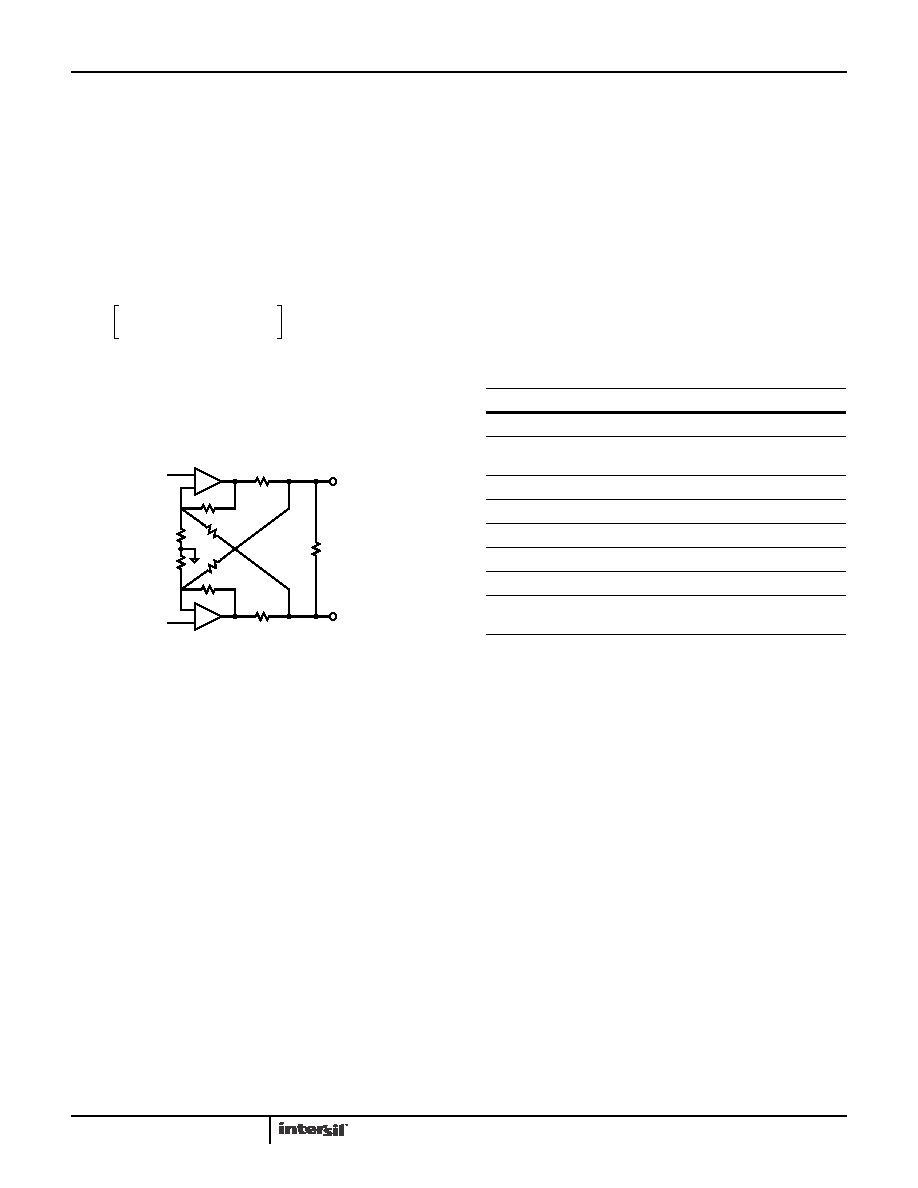- 您現(xiàn)在的位置:買賣IC網(wǎng) > PDF目錄1925 > ISL1532IRZ (Intersil)IC LINE DRIVER DUAL 24-QFN PDF資料下載
參數(shù)資料
| 型號: | ISL1532IRZ |
| 廠商: | Intersil |
| 文件頁數(shù): | 9/19頁 |
| 文件大?。?/td> | 0K |
| 描述: | IC LINE DRIVER DUAL 24-QFN |
| 標(biāo)準(zhǔn)包裝: | 90 |
| 類型: | 驅(qū)動器 |
| 驅(qū)動器/接收器數(shù): | 2/0 |
| 規(guī)程: | DSL |
| 電源電壓: | 5 V ~ 15 V |
| 安裝類型: | 表面貼裝 |
| 封裝/外殼: | 24-VFQFN 裸露焊盤 |
| 供應(yīng)商設(shè)備封裝: | 24-QFN(5x4) |
| 包裝: | 散裝 |
| 其它名稱: | Q3116466 |

17
FN6173.3
December 4, 2006
The overall gain of the active termination circuit is:
In an ADSL2+ system, the POTS phone line, a twisted pair
cable is used for data transmission. As shown in Figure 52,
the single ended active terminate line driver is reconfigured
to drive differential lines. The gain resistor is shared to allow
accurate gain matching between the two amplifiers. Applying
the same analysis technique as the single ended circuit, the
following relationship can be derived:
Table 3 is a quick comparison of the reduction in voltage and
power requirements for the driver with passive or active
termination. The key specification of a ADSL2+ CO driver
are as follows: Peak output line power is 20dBM, POTS line
impedance is 100
Ω and the crest factor for ADSL DMT
signal is 14.5dB. This specification translates to 16.76V
peak-to-peak voltage on the line with 5.3 peak to average
ratio PAR and 31.6mA average output current. In the passive
termination case where the load and backmatch resistors
are the same, the amplifier must provide 33.52V
peak-to-peak at its outputs. A high voltage line driver
typically needs 4V of total headroom. As a result the total
supply voltage required is 37.5V. With the necessary output
average current, that translates into 1.185W dissipated in
addition to the quiescent power of the amplifier.
In the active case, a K of 5 is assumed. This reduces the
backmatch resistor to 20% of its value in the passive case.
The peak-to-peak output voltage provided by the driver is
reduced to 20.11V which allows the use of the EL1508, a
median voltage line driver. The EL1508 requires 2.5V of
headroom. With 2.5V of supply voltage headroom, the power
supply required becomes 22.61. With the same output
current drive, the power dissipation is reduced by 39.7% to
0.714W. While it is true that additional power is dissipated in
the feedback networks, the feedback resistors are typically
much larger than the backmatch resistor and their losses are
negligible.
V+
R
P1
R
P1
R
P2
+
-----------------------------
V
X
×
=
V-
R
G
R
F
R
G
+
----------------------
V
O
×
=
R
SOURCE
V
X
I
X
-------
R
BM /
1 -
R
P1
R
P1
R
P2
+
-----------------------------
R
F
R
G
+
R
G
----------------------
×
==
R
SOURCE
R
L
KRBM
×
==
K1
1 -
R
P1
R
P1
R
P2
+
-----------------------------
R
F
R
G
+
R
G
----------------------
×
=
(EQ. 9)
V
O
V
IN
---------
R
P2 / RP2
R
P1
+
()
1
K
----
+
/
R
G
R
F
+
R
G
----------------------
-
R
P1
R
P2
R
P1
+
-----------------------------
-----------------------------------------------------------------------------------------------
=
(EQ. 10)
-
+
RF
RG
-
+
RF
RG
VIN-
VIN+
R
P
R P
VO-
VO+
RBM
RL
FIGURE 52. DIFFERENTIAL LINE DRIVER USING ACTIVE
TERMINATION TECHNIQUE
K
1 / 1 -
R
F
R
P
--------
=
V
OUT
V
IN
----------------
1R
F / RG
R
F / RP
+
21 -
R
F
R
P
--------
×
------------------------------------------------------------
=
(EQ. 11)
TABLE 3.
PASSIVE TERMINATION
ACTIVE TERMINATION
16.5VP-P into a 100Ω line
VOUT DRIVER = VRBM +
VRLOAD
VOUT DRIVER = VRBM +
VRLOAD
RBM = RLOAD
RBM = RLOAD/5
VRBM = VRLOAD
VRBM = VRLOAD/5
VOUT DRIVER = 33.52V
VOUT DRIVER = 20.11V
VSUPPLY = 37.52
VSUPPLY = 24.11
IOUT = 31.6mA
POUT DRIVER = VSUPPLY * IOUT
= 1.185W (plus quiescent power)
POUT DRIVER = VSUPPLY * IOUT
= 0.714W (plus quiescent power)
ISL1532
相關(guān)PDF資料 |
PDF描述 |
|---|---|
| ISL1536IRZ | IC LINE DRVR DUAL ADSL2+ 16-QFN |
| ISL1539AIRZ | IC VDSL2 LINE DVR AMP 24QFN |
| ISL1539IVEZ | IC VDSL2 LINE DVR AMP 24HTTSOP |
| ISL1557AIRZ | IC LINE DRIVER DUAL 16-QFN |
| ISL1557IUEZ | IC VDSL2 LINE DVR AMP 10HMSOP |
相關(guān)代理商/技術(shù)參數(shù) |
參數(shù)描述 |
|---|---|
| ISL1532IRZ-T13 | 制造商:Intersil Corporation 功能描述:ADSL DRVR DUAL 24QFN EP - Tape and Reel |
| ISL1532IRZ-T7 | 功能描述:緩沖器和線路驅(qū)動器 Dual Channel Diff. DSL Line Driver RoHS:否 制造商:Intersil 輸入線路數(shù)量: 輸出線路數(shù)量: 極性: 電源電壓-最大: 電源電壓-最小: 最大工作溫度:+ 85 C 安裝風(fēng)格: 封裝 / 箱體:QFN EP 封裝:Reel |
| ISL1532IVEZ | 制造商:Intersil Corporation 功能描述:OP AMP DUAL CURRENT FDBK 15V 20HTSSOP - Bulk 制造商:Rochester Electronics LLC 功能描述: |
| ISL1532IVEZ-EVAL | 制造商:Intersil Corporation 功能描述:ISL1532IVEZ-EVAL DEMO BOARD - Bulk |
| ISL1532IVEZ-T13 | 制造商:Intersil Corporation 功能描述:ADSL DRVR DUAL 20HTSSOP EP - Tape and Reel 制造商:Intersil Corporation 功能描述:Dual Channel Differential DSL Line Drive |
發(fā)布緊急采購,3分鐘左右您將得到回復(fù)。